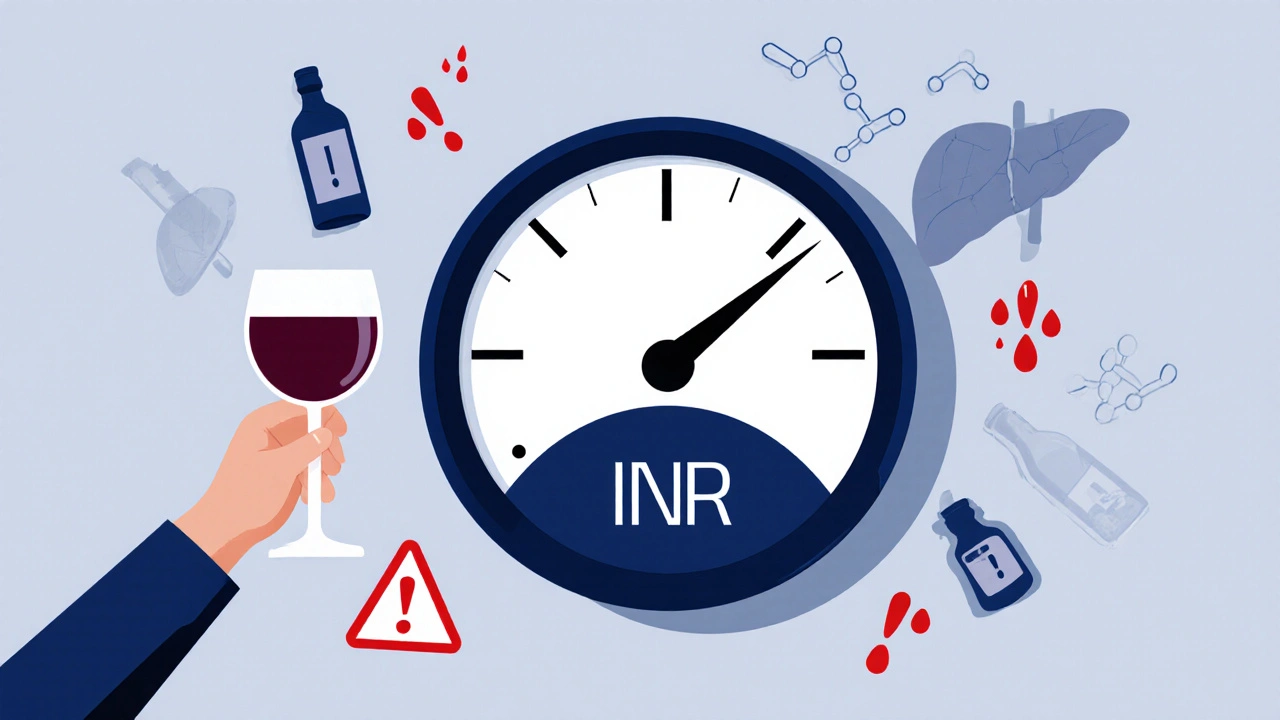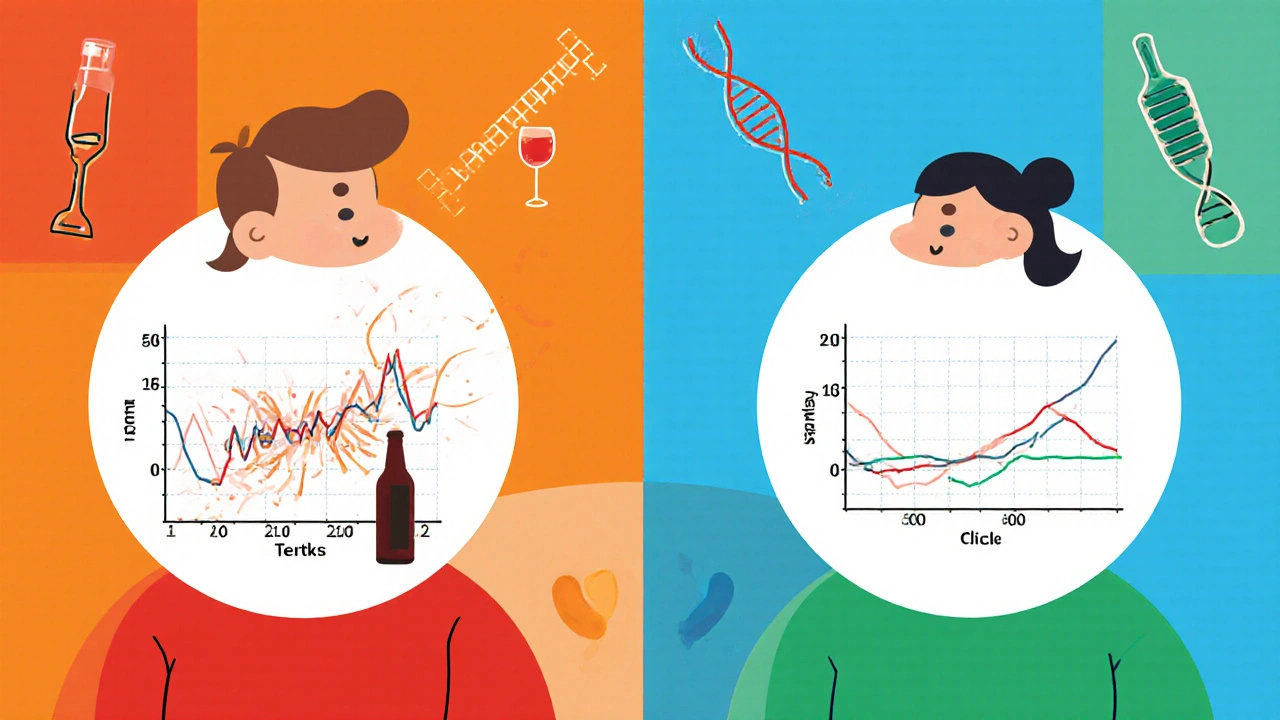
When you're on a blood thinner like warfarin, even a weekend drink can throw your blood off balance. It's not about being perfect-it's about understanding how alcohol quietly messes with your body's ability to clot. For millions of people taking warfarin, the real danger isn't just the medication itself, but what happens when it meets alcohol. The numbers don't lie: an INR above 3.5 means your bleeding risk jumps by 30-50%. And when alcohol gets involved, that number can spike overnight.
How Warfarin Works-and Why Alcohol Throws It Off
Warfarin, first approved in 1954, slows down your blood’s clotting process by blocking vitamin K. That’s good if you have atrial fibrillation or a mechanical heart valve-it stops dangerous clots from forming. But it’s a tightrope walk. Your therapeutic INR range is usually between 2.0 and 3.0. Go above 3.5, and you’re in danger zone. Below 2.0, you’re at risk of a stroke.
Alcohol doesn’t just make you dizzy-it interferes with how your liver breaks down warfarin. When you drink, especially heavily, your liver gets busy processing alcohol instead of warfarin. That means warfarin sticks around longer, building up in your system. The result? Your INR climbs. One study found that patients who drank heavily had INR levels above 9, a level where nearly 35% of hospitalized patients bled badly-and 17% died.
It’s not just about how much you drink. It’s about how often. Binge drinking-five or more drinks in one sitting-is worse than sipping wine over dinner. That sudden flood of alcohol shocks your system. Your INR can jump from 2.4 to 3.8 in just 48 hours. One patient in Sydney reported bleeding in his stomach after six pints of beer. His INR shot up from 2.8 to 5.2. That’s not rare. It’s textbook.
INR: The Silent Meter That Tells You When You’re in Danger
INR isn’t just a lab number. It’s your personal alarm system. Normal INR for someone not on blood thinners? 0.8 to 1.1. On warfarin? 2.0 to 3.0 for most people. If you have a mechanical mitral valve, your target might be 2.5 to 3.5. But once you hit 3.5, your risk of bleeding starts climbing fast. At INR 4.0, you’re three times more likely to bleed than at INR 2.5.
And alcohol makes this worse. A 2012 study showed that among patients with INR over 9, alcohol was one of the top three reasons for serious bleeding-alongside kidney problems and being over 65. Even more alarming: patients with INR above 9 who weren’t even on warfarin had a 67% chance of bleeding and a 74% death rate. That tells you how dangerous this combo really is.
What does an INR spike feel like? Nothing-until you bleed. That’s why regular testing is non-negotiable. If you drink, your doctor might ask you to test your INR twice a week instead of once a month. Some clinics now use telehealth apps that track your alcohol intake and adjust your testing schedule automatically. One study showed that patients who used these tools had 25% fewer dangerous INR spikes.
Warfarin vs. Newer Blood Thinners: Alcohol’s Role Changes
Not all blood thinners are the same. Warfarin is old, cheap, and finicky. It interacts with food, other meds, and yes-alcohol. That’s why you need INR checks every few weeks. But newer drugs like apixaban, rivaroxaban, and dabigatran don’t need regular blood tests. They’re simpler. And they don’t interact with alcohol the same way.
That doesn’t mean you can drink freely. Alcohol still thins your blood. It can irritate your stomach lining, making bleeding more likely. It can also mess with your liver, which processes all these drugs. So while a glass of wine won’t send your INR through the roof on apixaban, it still increases your overall bleeding risk.
The big difference? If you bleed on warfarin, doctors can reverse it with vitamin K or plasma. On newer drugs? Reversal is harder. And while newer drugs are safer overall, they’re also more expensive. Many people still take warfarin because it’s the only option covered by their insurance. That’s why understanding alcohol’s effect on warfarin still matters more than ever.

Genetics Play a Bigger Role Than You Think
Not everyone reacts to alcohol the same way on warfarin. Your genes decide how fast your body breaks it down. Two gene variants-CYP2C9*2/*3 and VKORC1 1173G>A-make you extra sensitive. People with these variants don’t just have higher INRs when they drink. They have dangerously high INRs.
A 2015 NIH study found that patients with these gene variants who drank alcohol had a much higher risk of major bleeding. The interaction wasn’t just additive-it was multiplicative. That means if you have these genes and drink, your risk isn’t 2x higher. It’s 4x, 5x, even more. The study showed statistical significance (p=0.04). This isn’t theory. It’s real.
Most doctors don’t test for these genes routinely. But if you’ve had unexplained INR spikes, or if your INR is hard to control even with no diet changes, ask about genetic testing. It might explain why your warfarin dose keeps changing-and why alcohol hits you harder than it does your friend.
What’s Safe? How Much Alcohol Can You Really Drink?
The British Heart Foundation says it’s okay to drink while on warfarin-if you stick to the limits. That’s 14 units a week for men, 7 for women. Spread over three or more days. No bingeing. No saving up drinks for the weekend.
What’s a unit? One small glass of wine (125ml), one pub measure of spirits (25ml), or half a pint of regular beer. That’s it. Two glasses of wine on Friday? Fine. Five on Friday? Dangerous. One drink a day? Probably okay. Three drinks on Saturday? High risk.
Medical News Today says heavy drinking means more than 14 drinks a week for men or 7 for women. That’s not a suggestion-it’s a red flag. A 62-year-old man in Melbourne had a life-threatening bleed after drinking 12 beers over two days. His INR was 6.1. He spent a week in hospital.
Consistency matters more than quantity. If you drink one glass of wine every Tuesday, your body adjusts. If you drink nothing for two weeks and then have six beers? Your INR will spike. Your doctor won’t know why. You’ll get blamed for not taking your pills. But it’s the alcohol, not you.

Signs You’re Bleeding-Don’t Wait for a Hospital
Most people don’t realize they’re bleeding until it’s too late. Here’s what to watch for:
- Red or brown urine
- Tar-like or bright red stools
- Bleeding gums that won’t stop
- Nosebleeds that last more than 10 minutes
- Unusual bruising-big, dark patches with no bump
- Heavier periods than normal
- Brown or bright red vomit
- Severe headaches, dizziness, or vision changes (could mean brain bleed)
If you notice any of these after drinking, get your INR checked today. Don’t wait. Don’t assume it’s "just a nosebleed." A small bleed can turn into a stroke or internal hemorrhage in hours.
What to Do If You’ve Already Drank
You had a few drinks. Now you’re worried. Here’s what to do:
- Don’t panic. One drink won’t kill you.
- Don’t take an extra dose of warfarin. That’s the opposite of what you need.
- Don’t skip your next INR test. Make it sooner if you can.
- Call your anticoagulation clinic. Tell them you drank. They’ll tell you if you need to come in.
- Write it down. Note how much you drank and when. Bring it to your next appointment.
Some patients keep a simple log: "Mon: 1 glass wine. INR: 2.6. Wed: 3 beers. INR: 3.9." That kind of data helps your doctor see patterns. It’s not about guilt. It’s about control.
Bottom Line: Alcohol Isn’t the Enemy-Unpredictability Is
You don’t have to quit alcohol. But you have to treat it like a variable in your medication equation. Warfarin is precise. Alcohol is chaos. Together, they create risk you can’t control.
Stick to the limits. Spread it out. Avoid bingeing. Test your INR regularly-especially after drinking. Know the signs of bleeding. Talk to your doctor about your habits. And if you’ve got the genetic variants? Be extra careful.
This isn’t about fear. It’s about power. You can still enjoy a drink. But only if you understand how it changes your body’s balance. That’s the only way to stay safe-and stay alive.
Can I have one glass of wine while on warfarin?
Yes, one standard glass of wine (125ml) is generally safe if you drink it consistently and don’t binge. But even one drink can affect your INR, especially if you have certain genetic variants. Always check your INR regularly and tell your doctor if you drink.
Does alcohol raise INR immediately?
Not always immediately, but within 24 to 48 hours after drinking-especially after bingeing. Alcohol slows how your liver clears warfarin, causing it to build up. That’s why INR spikes often show up a day or two after you’ve had drinks.
Is it safer to use a newer blood thinner than warfarin if I drink?
Newer blood thinners like apixaban or rivaroxaban don’t interact with alcohol the same way warfarin does, so INR spikes aren’t a concern. But alcohol still increases bleeding risk by irritating your stomach and liver. So while you don’t need INR checks, you still need to limit alcohol.
What should I do if my INR is too high after drinking?
If your INR is above 5.0, contact your doctor immediately. Do not take more warfarin. Avoid alcohol until your INR is back in range. In severe cases (INR >9), doctors may give vitamin K or plasma to reverse the effect. Never try to fix it yourself.
Can I drink alcohol if I’m on warfarin and have liver disease?
No. If you have liver disease, your body already struggles to process warfarin. Adding alcohol makes it worse. Even small amounts can cause dangerous INR spikes and increase bleeding risk significantly. Your doctor will likely advise complete abstinence.
How often should I get my INR tested if I drink alcohol?
If you drink regularly-even moderately-your doctor may recommend testing every 1-2 weeks instead of monthly. After binge drinking, get tested within 48 hours. Keep a log of your drinks and INR results. This helps your doctor adjust your dose before something serious happens.

Post A Comment